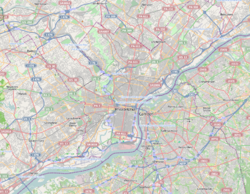Clark Park
| Clark Park | |
|---|---|
| Clarence H. Clark Park | |

An August 2007 performance of "Romeo and Juliet" by Shakespeare in Clark Park.
|
|
| Location | West Philadelphia, Pennsylvania |
| Coordinates | 39°56′51″N 75°12′36″W / 39.94751°N 75.21004°WCoordinates: 39°56′51″N 75°12′36″W / 39.94751°N 75.21004°W |
| Area | 9.1 acres |
| Created | 1895 |
| Operated by | Philadelphia Parks & Recreation |
| Status | Always open |
| Website | |
|
Clark Park
|
|
| Location | Pennsylvania |
| Coordinates | 39°57′1″N 75°12′45″W / 39.95028°N 75.21250°W |
| Area | 640 acres (259 ha) |
| Architect | multiple |
| Architectural style | Queen Anne, Colonial Revival, Classical Revival |
| Part of | West Philadelphia Streetcar Suburb Historic District (#97001669) |
| Added to NRHP | February 5, 1998 |
Clark Park is a municipal park in the Spruce Hill section of West Philadelphia in Philadelphia, Pennsylvania. Its 9.1 acres (3.7 ha) are bordered by 43rd and 45th streets, and by Baltimore and Woodland Avenues.
The park was established in 1895 on land donated to the city by banker and West Philadelphia developer Clarence Howard Clark, and was known in its early decades as "Clarence H. Clark Park".
Today, the park has a basketball court, playground, an open field, and many paths. It holds a life-sized 1890 sculpture of Charles Dickens, one of just two known statues of the author. It is home to the Shakespeare in Clark Park theatre company.
The park also hosts Philadelphia's largest year-round farmers' market, which runs once or twice a week, depending on the season.
During the American Civil War, a small portion of the land that would later become Clark Park was occupied by the southern tip of the 16-acre grounds of Satterlee Hospital, one of the largest Union Army hospitals. Some 60,000 Union soldiers were treated at the medical facility, which was torn down after the war.
A prominent feature of the park is its "bowl", once a mill pond that powered a paper mill and another mill to the south. An ice house sat near its southern tip. The pond was fed by Mill Creek, which ran through a ravine between 42nd and 43rd Streets, was dammed above Woodland Avenue, and emptied into the Schuylkill River.
...
Wikipedia



